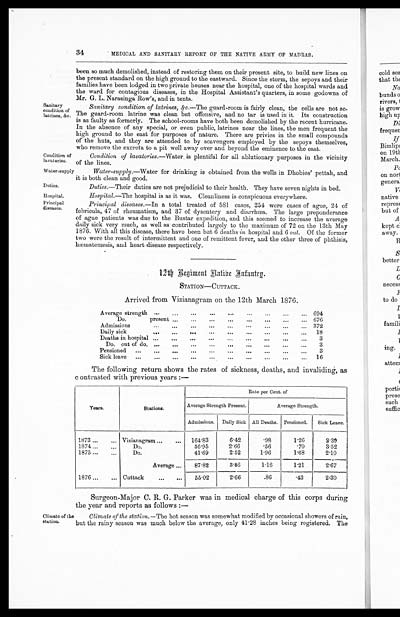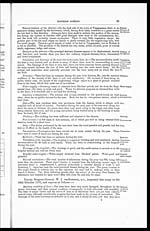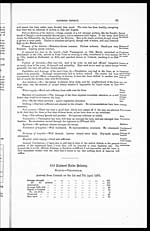Medicine - Institutions > Army health reports and medical documents > Medical and sanitary reports of the native army of Madras > Medical and sanitary report of the native army of Madras for the year 1876
(43) Page 34
Download files
Individual page:
Thumbnail gallery: Grid view | List view

34
MEDICAL AND SANITARY REPORT OF THE NATIVE ARMY OF MADRAS.
been so much demolished, instead of restoring them on their present site, to build new lines on
the present standard on the high ground to the eastward. Since the storm, the sepoys and their
families have been lodged in two private houses near the hospital, one of the hospital wards and
the ward for contagious diseases, in the Hospital Assistant's quarters, in some godowns of
Mr. G. L. Narasinga Row's, and in tents.
Sanitary
condition of
latrines, &c.
Sanitary condition of latrines, &c.— The guard-room is fairly clean, the cells are not so.
The guard-room latrine was clean but offensive, and no tar is used in it. Its construction
is as faulty as formerly. The school-rooms have both been demolished by the recent hurricane.
In the absence of any special, or even public, latrines near the lines, the men frequent the
high ground to the east for purposes of nature. There are privies in the small compounds
of the huts, and they are attended to by scavengers employed by the sepoys themselves,
who remove the excreta to a pit well away over and beyond the eminence to the east.
Condition of
lavatories.
Condition of lavatories.— Water,is plentiful for all ablutionary purposes in the vicinity
of the lines.
Water-supply
Water-supply.— Water for drinking is obtained from the wells in Dhobies' pettah, and
it is both clean and good.
Duties.
Duties.— Their duties are not prejudicial to their health. They have seven nights in bed.
Hospital
Hospital.— The hospital is as it was. Cleanliness is conspicuous everywhere.
Principal
diseases
Principal diseases.— In a total treated of 581 cases, 254 were cases of ague, 24 of
febricula, 47 of rheumatism, and 37 of dysentery and diarrhœa. The large preponderance
of ague patients was due to the Bustar expedition, and this seemed to increase the average
daily sick very much, as well as contributed largely to the maximum of 72 on the 13th May
1876. With all this disease, there have been bat 6 deaths in hospital and 6 out. Of the former
two were the result of intermittent and one of remittent fever, and the other three of phthisis,
hæmatemesis, and heart disease respectively.
12th Regiment Native Infantry.
STATION—CUTTACK.
Arrived from Vizianagram on the 12th March 1876.
| Average strength | 694 |
| Do. present | 676 |
| Admissions | 372 |
| Daily sick | 18 |
| Deaths in hospital | 3 |
| Do. out of do. | 3 |
| Pensioned | 3 |
| Sick leave | 16 |
The following return shows the rates of sickness, deaths, and invaliding, as
contrasted with previous years:—
| Years. | Stations. | Rate per Cent. of | ||||
| Average Strength Present. | Average Strength. | |||||
| Admissions. | Daily Sick | All Deaths. | Pensioned. | Sick Leave. | ||
| 1873 | Vizianagram | 164.83 | 6.42 | .98 | 1.26 | 2.39 |
| 1874 | Do. | 56.95 | 2.66 | .56 | .70 | 3.52 |
| 1875 | Do. | 41.69 | 2.52 | 1.96 | 1.68 | 2.10 |
| Average | 87.82 | 3.86 | 1.16 | 1.21 | 2.67 | |
| 1876 | Cuttack | 55.02 | 2.66 | .86 | .43 | 2.30 |
Surgeon-Major C. R. G. Parker was in medical charge of this corps during
the year and reports as follows:—
Climate of the
station.
Climate of the station.— The hot season was somewhat modified by occasional showers of rain,
but the rainy season was much below the average, only 41.28 inches being registered. The
Set display mode to: Large image | Zoom image | Transcription
Images and transcriptions on this page, including medium image downloads, may be used under the Creative Commons Attribution 4.0 International Licence unless otherwise stated. ![]()
| Permanent URL | https://digital.nls.uk/74991433 |
|---|




